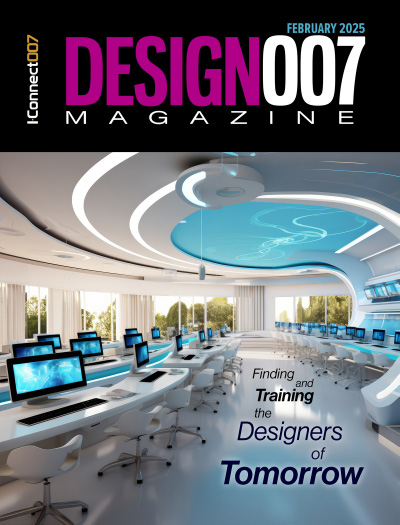-

- News
- Books
Featured Books
- design007 Magazine
Latest Issues
Current Issue
Designing Through the Noise
Our experts discuss the constantly evolving world of RF design, including the many tradeoffs, material considerations, and design tips and techniques that designers and design engineers need to know to succeed in this high-frequency realm.

Learning to Speak ‘Fab’
Our expert contributors clear up many of the miscommunication problems between PCB designers and their fab and assembly stakeholders. As you will see, a little extra planning early in the design cycle can go a long way toward maintaining open lines of communication with the fab and assembly folks.

Training New Designers
Where will we find the next generation of PCB designers and design engineers? Once we locate them, how will we train and educate them? What will PCB designers of the future need to master to deal with tomorrow’s technology?
- Articles
- Columns
Search Console
- Links
- Media kit
||| MENU - design007 Magazine
Planning Your Design Education Strategy
March 9, 2022 | Andy Shaughnessy, Design007 MagazineEstimated reading time: 2 minutes
There are (finally) some young people joining the PCB design and design engineering community. We’re glad to see their youthful faces at trade shows and conferences. But if you’re a recent grad and working in your first “real” job, you might be asking yourself: How do I set up an education and training plan for my career in PCB design? What’s my next step?
We asked Eric Bogatin to weigh in with his thoughts. Eric has a unique viewpoint: He’s a veteran signal integrity instructor, as well as a professor in the College of Engineering and Applied Science at the University of Colorado, Boulder. In this interview, Eric lays out some of his planning strategies and the need for a degree in electrical engineering in the PCB design world.
Andy Shaughnessy: Eric, how do you help your students plan their educational objectives at the college?
Eric Bogatin: This is an important question. It is never too early to start thinking about what your career goals are, either working in the industry or just as a student. If a student is not 100% clear and dedicated to a particular path, I encourage them to use the opportunity as an undergraduate to experiment and explore topics. They need to get enough experience to figure out what they like—design, measurement, software, simulation, circuits, fields, designing systems, working with people, working behind a computer, teaching, or something else.
Once they have a sense of what they really enjoy and a plan, then we select courses to help support that path. Because of the core courses most EE students need to take, there is not a lot of flexibility, but there are usually four or five electives that a student can select.
Shaughnessy: What criteria should designers keep in mind when evaluating their educational needs in the industry?
Bogatin: You need a balance between the fundamental principles and the hands-on experience applying these principles. Taking online classes is fine, but plan to get some kits so you can actually build and measure circuits. Taking some courses in which you will get experience designing and building reference designs will help build your confidence.
Shaughnessy: What would you advise to PCB designers who want to set up their own strategic learning plans?
Bogatin: If you want to be a PCB designer, rather than a circuit designer and hardware designer, then you probably don’t need a BSEE degree. Just getting some electronics experience and training in designing and building some boards is good enough to get started. But if you are going to be a hardware engineer and take responsibility for the circuit design and do the board design, then a BSEE and lots of hands-on experience designing and building circuits is important. You cannot get too much experience building working circuits in a solderless breadboard to gain experience in debugging and characterizing circuits.
To read this entire conversation, which appeared in the March 2022 issue of Design007 Magazine, click here.
Suggested Items
Siemens Expands Global Electronics Intelligence Reach and Supplyframe Portfolio with Wevolver Acquisition
04/30/2025 | Siemens Digital Industries SoftwareSiemens Digital Industries Software announced its intention to acquire Wevolver, expanding its audience reach, enhancing the Supplyframe product portfolio, and combining digital marketing and integrated campaign programs that include go-to-market support and content creation.
Siemens, Intel Foundry Advance Collaboration
04/30/2025 | Siemens Digital Industries SoftwareSiemens Digital Industries Software announced that its continued collaboration with Intel Foundry has resulted in multiple product certifications, updated foundry reference flows, and additional technology enablement leveraging the foundry’s leading-edge technologies for next-generation integrated circuits (IC) and advanced packaging.
Keysight EDA, Intel Foundry Collaborate on EMIB-T Silicon Bridge Technology for Next-Generation AI and Data Center Solutions
04/30/2025 | BUSINESS WIREKeysight Technologies, Inc. announced a collaboration with Intel Foundry to support Embedded Multi-die Interconnect Bridge-T (EMIB-T) technology, a cutting-edge innovation aimed at improving high-performance packaging solutions for artificial intelligence (AI) and data center markets in addition to the support of Intel 18A process node.
Fresh PCB Concepts: Key Considerations for Reliability, Performance, and Compliance in PCBs
04/29/2025 | Team NCAB -- Column: Fresh PCB ConceptsAs a field application engineer with many years of experience, I’ve conducted thousands of designs for manufacturing (DFM) analyses on printed circuit boards (PCBs). From basic one-layer boards to complex high density interconnect (HDI) designs, I’ve provided technical advice across a wide spectrum of technologies.
Congatec Showcases High-performance Embedded Building Blocks at ElectroneX 2025
04/29/2025 | congateccongatec, a leading vendor of embedded and edge computing technology, will present its latest high-performance hardware and software building blocks at ElectroneX 2025, taking place at the Melbourne Convention and Exhibition Centre from May 7-8.


